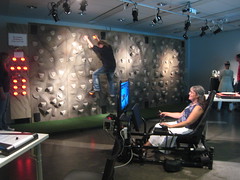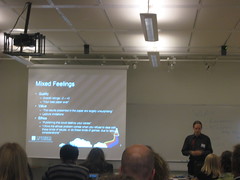These are my live diary notes from the first day of the conference.
I started out by going to the Nordic Digra Chapter meeting, and then catching the second half of the workshop on Collecting and analyzing video data in game studies led by Jonas Linderoth, Ulrika Bennerstedt & Björn Sjöblom. We looked at videos and transcripts of players playing a console game. I was in the group Jonas moderated.

Next was Jesper Juul’s keynote where he took a large perspective and talked about the notion of casual games, how it has emerged during the past five years, and how the term is used by among others hard core gamers.
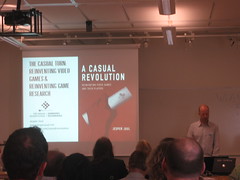
Paper Session: Playing Experience
Kivikangas et al., Psychophysiological method in studying game experience
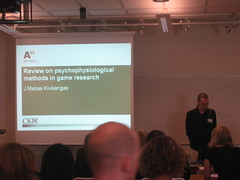
What do we really know? Not much. Because studies are scattered. Different approaches. Little accumulated knowledge.
Also: it is difficult. Not well defined. Own theories. Not clear what theories are effective. Not easy to combine with game studies.
Measure physiology to study psychology. The ‘bible’ by Cacioppo (2007) doesn’t have a word about games.
so why use them; objective except for the researchers interpretations
How use them? Experimental and applied research. Study the experience: emotions and attention. Problem example: the muscle on the brow which is a measure of displeasure is also the measure of concentration. There is not one to one relations between physiology and psychology. Need to be interpreted, and the experiments must be carefully designed.
Many methodological problems.
Many methodological problems.
Why bother, what are they good for?
They are complicated, but when used properly they are powerful. No other methods are objective precise etc.
They are complicated, but when used properly they are powerful. No other methods are objective precise etc.
Future: hopes for more experimental research so knowledge can be accumulated.
//Great that they made a review paper. Helpful. I'll read it.
//Great that they made a review paper. Helpful. I'll read it.
Noergaard, Stillborn Gamers? Writing a Birth Certificate for Corporeality and Motility in Game Studies
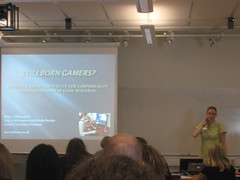
introducing with a video clip.
“the gamer game” Arguing that the corporality, the motion of the body of the player is not studied enough. Rythm.
Marcus: connects to our (GS community) embarrassing ignorance of sport studies.
Linderoth, Why gamers don’t learn more: An ecological approach to games as learning environments
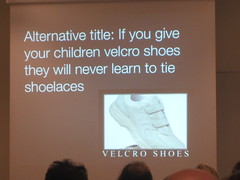
about learning - alternative title about that children don’t learn to tie their shoes if they get welcro shoe things. Games. Gibson. Ecological systems. Affordances. They are relative. Not objective properties of an environment. Always relative to an agent. Affordance: the ‘empty fit’ between the agent and the environment. The affordances needs to be discovered. Learn to realize the affordances. Rock-climbing for example. Need to learn what surfaces to grip. Perception and action are closely related. We act upon affordances.
exploratory actions - learn what performances are afforded
performatory actions - already learned the affordance.
Example video clip where a player tries to shoot a couple human-like figures, but nothing happens. He realizes there is no affordance there. Then discovers that only objects with arrows on have affordances. highlighted objects, points of interest - games use good codes for signalling that there is an affordance. makes argument that ‘avatars are the tools we use in digital environment’dynamics of the game play can be guilt into the avatar. Gain different affordances...many ways to change the affordances....
QA
Jesper: but you ...talk about a role-playing game? whith characters skill progression?
//Association to the bioware-speech at gdc when avatar motion and targeting was enhanced to make players feel more hero-like. I feel that I don’t understand what point Jonas is making, I’ll need to read the paper. I associate to the design of the action potential of avatars and world designs... but everybody knows this, it can’t be Jonas’ point ok... What he says now that this is something UNIQUE in games, that there is these both explorative and performative affordances/actions. Ok. I’ll read the paper and I will keep quiet now.
Paper Session: Role-Playing Games
Bergström et al., Undercurrents A Computer-Based Gameplay Tool to Support Tabletop Roleplaying
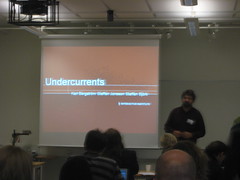
//I think it is the same tools as they showed at the Tampere workshop?...yes it is.
Abstract:"This paper introduces Undercurrents, a computer-based gameplay tool for providing additional communication and media streams during tabletop roleplaying sessions. [...] "
B: Players use a surprisingly high amount of technology when role-playing today as opposed to just a few years ago, perhaps because of the rise of ubiquitous computing.
Ground Zero. Much discussed LARP.
// i recognise Marcus’ talk from his speech at digra last year.
The Journey - the rape game. These types of games are gratifying but not fun. “The Journey”, “Gang Rape”.
Comparable to shindlers list and other strong emotional experiences. “They don’t fit into the categories for playful experience research I made.”
QA
Jonas Linderoth: But is it game - what if it was called an educational drama?
MM: therapist wanted the CDs, terapist specialising in rape victims.
Annika: It is illegal to play them, so be careful.
MM: the painstation (electronic chock in pong game - chock when fail.)
me: train. Brathwaite.
Gunilla: Why?
MM: artistic experience.
Marie: strong political statement.
Designer is present. Wrigstad.
// i recognise Marcus’ talk from his speech at digra last year.
The Journey - the rape game. These types of games are gratifying but not fun. “The Journey”, “Gang Rape”.
Comparable to shindlers list and other strong emotional experiences. “They don’t fit into the categories for playful experience research I made.”
QA
Jonas Linderoth: But is it game - what if it was called an educational drama?
MM: therapist wanted the CDs, terapist specialising in rape victims.
Annika: It is illegal to play them, so be careful.
MM: the painstation (electronic chock in pong game - chock when fail.)
me: train. Brathwaite.
Gunilla: Why?
MM: artistic experience.
Marie: strong political statement.
Designer is present. Wrigstad.
Reception at DAC in Kista.

The reception was held in the new Digital Arts showroom in Kista that Ingvar and his group at the Interactive Instititute has built up together with DSV. It was really really nice, I immediately felt good vibes when entering. They’ve managed to create a good balance of the works exhibited; both historically important works, a variety of new and quirky projects on display and pieces which are fun to interact with, such as the wall climbing game. Ingvar and one of his co-workers showed us around. Also, Crister Engström from Dreamhack gave a presentation and invited everyone warmly to Dreamhack, next time is in November. I came to think about TL's and Emma's paper from FDG. I hope I'll be able to go there sometime, DH has this tendency to clash with other stuff I need to travel to.
